
Joint Task Force 2 is Canada's Tier 1 special operations force mandated with protecting Canadian national interests and combating terrorism threats both domestic and abroad.JTF 2 serves under the Canadian Special Operations Forces Command of the Canadian Armed Forces and is typically compared to American Delta Force and SEAL Team Six, the British Special Air Service, the Australian Special Air Service Regiment and New Zealand Special Air Service. Most information concerning JTF 2 is classified and is not usually commented on by the Canadian Armed Forces or the Government of Canada.

The National Security Guard (NSG), commonly known as Black Cats, is a counter-terrorism unit of India under the Ministry of Home Affairs. It was founded on 16 October 1984, following Operation Blue Star, to combat terrorist activities and protect states against internal disturbances. Formalised in the Parliament of India under the National Security Guard Act, 1986. It is one of the seven Central Armed Police Forces of India.
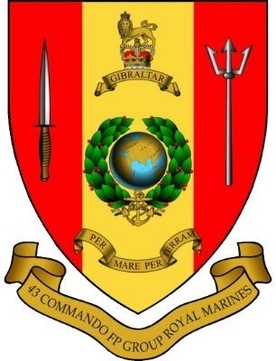
The 43 Commando Fleet Protection Group Royal Marines, formerly Comacchio Company Royal Marines (1980–1983), Comacchio Group Royal Marines (1983–2001) and Fleet Protection Group Royal Marines (2001–2012), is a 550-man unit of the Royal Marines responsible for guarding the United Kingdom's nuclear weapons. The unit, based at HM Naval Base Clyde, is part of 3 Commando Brigade.
The Iraqi Ground Forces, or the Iraqi Army, is the ground force component of the Iraqi Armed Forces. It was formerly known as the Royal Iraqi Army up until the coup of July 1958.

The Mk 14 Enhanced Battle Rifle (EBR) is an American military selective fire battle rifle, and a designated marksman rifle chambered for the 7.62×51mm NATO cartridge. It is a variant of the M14 battle rifle and was originally built for use with units of United States Special Operations Command, such as the United States Navy SEALs, Delta Force, and task specific Green Berets ODA teams/units.

The Iraqi Police (IP) is the uniformed police force responsible for the enforcement of civil law in Iraq. Its organisation, structure and recruitment were guided by the Coalition Provisional Authority after the 2003 invasion of Iraq, and it is commanded by the reformed Iraqi Ministry of the Interior. "IP" refers to the Iraqi Police, and "ISF" to the broader Iraqi security forces. The current commander of the Federal Police Forces is Lieutenant General Raed Shaker Jawdat.
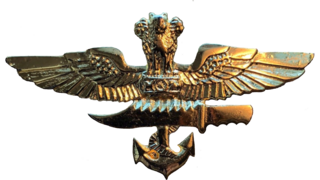
The Marine Commandos, abbreviated to MARCOS and officially called the Marine Commando Force (MCF), are the special forces of the Indian Navy. The MARCOS were originally named Indian Marine Special Force, which was later changed to Marine Commando Force to impart "an element of individuality" to it, according to the Indian Navy. The abbreviation 'MARCOS' was coined afterwards.

Para (Special Forces), also known as Para Commandos or Para (SF) Commandos, is a group of special forces battalions of the Parachute Regiment in the Indian Army. These units specialize in various roles including counter-terrorism, hostage rescue, unconventional warfare, special reconnaissance, counter-insurgency and direct action.

The 36th Commando Battalion is one of several Iraqi special operations forces units created after the fall of the Saddam Hussein. Originally part of the Iraqi Special Operations Forces Brigade, the unit has a role comparable to that of the United States Army Rangers. The unit is now designated as the 1st Commando Battalion, part of the 1st Special Operations Brigade.

Unit 217, frequently called Duvdevan, is a mistaʽaravim unit in the Commando Brigade of the Israel Defense Forces.
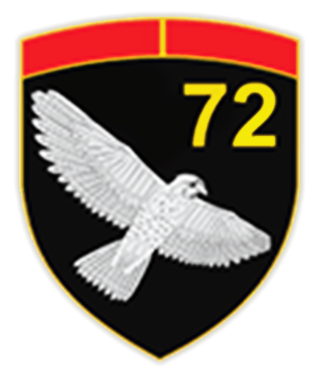
The 72nd Brigade for Special Operations is a special forces unit, one of two special forces brigades of the Serbian Armed Forces. It is under the command of the General Staff and is based at Pančevo.
The Lautaro Special Operations Brigade is Chilean Army's special operations forces unit. It is made up of units of special forces operators, land, mountain and paratroopers, tactical divers, and snipers.

65th Airborne Special Forces Brigade, or the NOHED Brigade, is an airborne, special forces unit of the Iranian Army established in 1959.
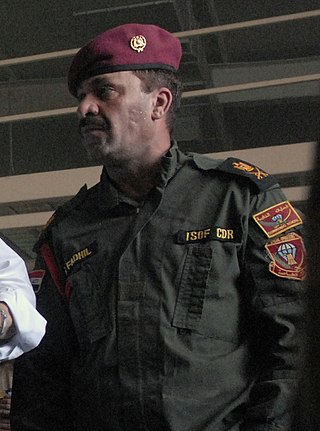
Fadhil Jamil Barwari was an Iraqi general who served as the commander of the Special Forces of Iraq. Graduated from the Second Military College in Zakho, Barwari is known for his key role in retaking cities back that were previously controlled by Daesh during the War in Iraq 2013-2017.
During the course of the Battle of Mosul (2016–17), an international coalition, primarily composed of the Iraqi Army, Kurdish Peshmerga, CJTF–OIR, along with the allied Popular Mobilization Forces, Company A, 2-502 Infantry Regiment, 101st Airborne Division, captured Mosul from the Islamic State, which had used Mosul as the capital for the Iraqi half of its "caliphate".
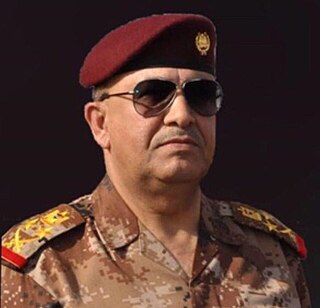
Talib Shaghati Mishari Kinani, is an Iraqi General and who served as the commander of the Iraqi Special Operations Forces. Shaghati is known for leading the ISOF unit in the 2013-2017 War in Iraq as well as participating in the Iran-Iraq War. He graduated from the Military College Course (49) in 1970, graduated from the College Leadership Course (7), graduated from the Staff College Course (50). After graduating from the military college he worked in the field artillery category and then participated in the basic missile course in 1971 in the Soviet Union and became a class of air defense / missiles. He worked in the air defense units and in the series of positions until he reached the commander of the air defense brigade, then the dean of the air defense institute and finally the dean of the air defense college and the rank of air defense brigade in 2001. Participated in the course of the leaders of fire brigades air defense in the Arab Republic of Egypt in 1983 and completed all courses of the basic category specialist.

The Ops-Core Future Assault Shell Technology (FAST) Helmet, also known as the FAST helmet, is an American combat helmet used by special operations forces and law enforcement organizations in various countries, as well as the current standard protective headgear of the Norwegian Armed Forces.
Salam Jassem Hussein al-Obeidi is an Iraqi officer who received media appraisal during the second Iraqi civil war and the Second battle of Mosul (2016–2017). Salam Hussein is now Colonel.



















